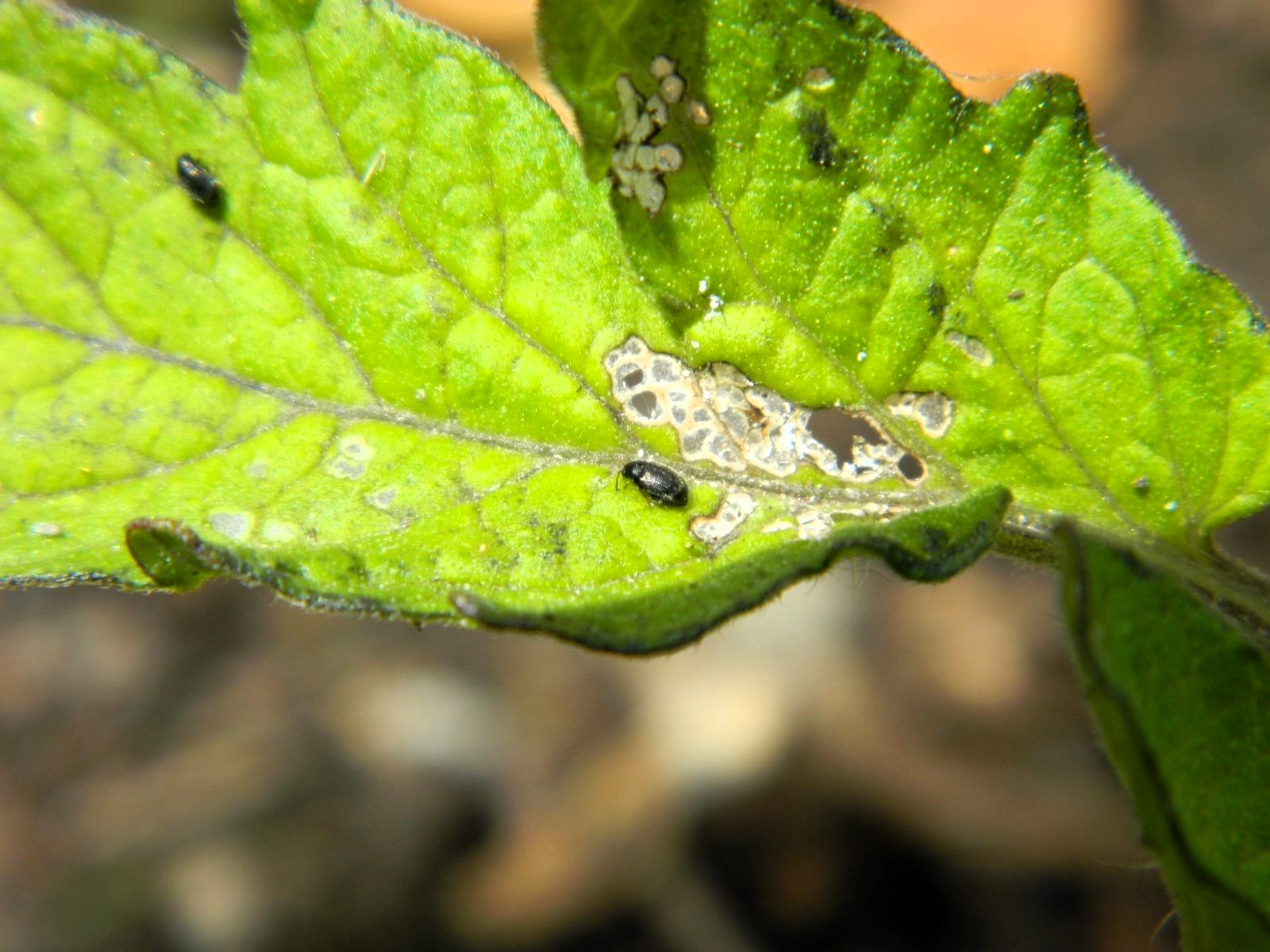Tomato plants, the pride of many gardeners, often attract small black winged insects that can harm leaves, stunt growth, and reduce fruit production. These pests, including aphids, fungus gnats, and whiteflies, aren’t just a nuisance; they have the potential to cause significant damage if left unchecked. Let’s dive into understanding these common pests, why they appear on your tomatoes, and the most effective strategies to control and prevent them naturally.
The Usual Suspects: Common Black Winged Pests on Tomato Plants
While multiple insect species can target tomato plants, the most frequent small black-winged pests that gardeners face include aphids, fungus gnats, and whiteflies. Here’s how to identify each and understand their impact on your plants:
- Aphids
These tiny insects, which often gather in clusters on leaves and stems, are one of the most common pests of tomato plants. With black, green, or brown bodies, aphids thrive by sucking sap from the plants. The honeydew they excrete can attract mold, which hinders photosynthesis, leaving leaves weakened and vulnerable. - Fungus Gnats
While fungus gnats themselves don’t harm plants directly, their larvae feed on organic matter and sometimes plant roots. Overwatering and poor soil drainage often lead to fungus gnat infestations. They are generally found flying around moist soil, indicating that they’re probably targeting your tomatoes’ roots and potting medium. - Whiteflies
Though smaller and often unnoticed at first, whiteflies cause considerable harm by draining nutrients from tomato plants. Similar to aphids, whiteflies excrete honeydew that invites mold, affecting plant health and crop yield. They lay their eggs on the undersides of leaves, where larvae continue to draw nutrients.
Why These Insects Are Attracted to Tomato Plants
Understanding what attracts pests to tomato plants can help you prevent future infestations. The primary factors drawing small winged pests to tomatoes include:
- Moisture Levels
Fungus gnats thrive in damp conditions. Tomatoes, especially young or potted plants, are frequently overwatered, leading to the damp soil conditions that fungus gnats love. - Dense Plant Growth
Tomato plants with dense foliage create a humid, shaded environment that provides aphids and whiteflies with a protected space. These insects find dense tomato growth an ideal spot for feeding and breeding. - Nutrient-Rich Environments
Aphids and whiteflies gravitate toward lush, nutrient-rich plants like tomatoes. The high nitrogen levels common in tomato fertilizers can make these plants an attractive target.
Signs of an Infestation: How to Spot Pests on Tomato Plants
Identifying a pest problem early allows you to tackle it before it becomes severe. Here are the main signs of small black-winged pests on tomato plants:
- Visible Clusters or Small Flecks on Leaves
Aphids gather in clusters on leaves and stems. If you notice small black specks, check the underside of leaves and stems where these insects are likely hiding. - Wilted or Curled Leaves
Aphids, whiteflies, and fungus gnats weaken the plant by draining nutrients, often leading to wilted, curled, or discolored leaves. - Presence of Honeydew and Mold
Aphids and whiteflies leave behind a sticky residue called honeydew, which can lead to sooty mold. This mold looks like a black or dark gray film on leaves and reduces photosynthesis. - Flying Insects
Fungus gnats are easy to spot as they hover around soil, particularly when disturbed. Whiteflies scatter when you shake or move the leaves.
Natural Ways to Control Black Winged Pests on Tomato Plants
Using natural pest control methods protects your tomatoes from damage without introducing harmful chemicals. Here are some practical methods to control these pests:
- Encourage Beneficial Insects
Ladybugs, lacewings, and parasitic wasps are natural predators of aphids and whiteflies. Introducing these insects into your garden can help you reduce pest populations. - Neem Oil Spray
Neem oil, a natural insecticide, is effective against aphids and whiteflies. It disrupts the life cycle of pests, preventing them from reproducing. Mix neem oil with water and a few drops of dish soap, then spray it directly on the affected plants every 7–10 days. - Insecticidal Soap
Safe for use on vegetables, insecticidal soap suffocates aphids and whiteflies on contact. Spray the leaves and stems thoroughly, especially on the undersides where these insects tend to hide. - Diatomaceous Earth
For fungus gnats, sprinkle a thin layer of diatomaceous earth on the soil surface. This natural powder kills insects by damaging their exoskeleton, making it a powerful deterrent. - Sticky Traps
Yellow sticky traps work well to capture flying pests like whiteflies and fungus gnats. Place these traps near the base of the plants or attach them to the branches where pests are active. - Homemade Garlic or Pepper Spray
Garlic and pepper have strong scents that deter pests. Blend garlic or chili peppers with water and strain the mixture, then spray it on your tomato plants to ward off aphids and whiteflies.
Preventing Future Infestations
Once you’ve managed to control the pests on your tomato plants, focus on prevention. Keeping pests away is often more manageable than eradicating them after they appear.
- Avoid Overwatering
Keep the soil moderately moist to avoid creating conditions that attract fungus gnats. Allow the top inch of soil to dry out between waterings. - Prune Regularly
Regular pruning improves airflow around tomato plants, reducing the humidity that attracts aphids and whiteflies. Removing dead or yellowing leaves also reduces hiding spots for pests. - Plant Companion Plants
Marigolds, basil, and nasturtiums naturally deter pests. Marigolds repel whiteflies and aphids, while basil helps control aphids. Nasturtiums, often planted at the base of tomato plants, act as a trap crop, drawing aphids away from tomatoes. - Maintain Healthy Soil
Healthy soil encourages robust plant growth, making tomatoes less susceptible to pests. Adding compost or organic matter to your soil improves drainage and reduces the likelihood of fungus gnat infestations. - Inspect New Plants
When introducing new plants to your garden, check them carefully for pests before planting. This precaution helps prevent introducing aphids, whiteflies, or fungus gnats into your tomato garden.
The Impact of Black Winged Pests on Tomato Production
Small black-winged pests do more than harm the aesthetic appeal of tomato plants. Their presence can significantly reduce fruit yield by stunting plant growth, damaging foliage, and decreasing photosynthesis. Aphids, for example, weaken plants over time, reducing fruit production. Whiteflies not only damage plants but can also transmit viruses that affect tomato health and yield. When plants are weakened by nutrient loss, they struggle to produce healthy, robust tomatoes.
Monitoring and Early Detection Techniques
Regular monitoring can help you identify and address pest problems before they escalate. Here’s how to keep a close watch on your plants:
- Visual Inspection
Every few days, inspect your tomato plants, paying attention to new growth, undersides of leaves, and soil moisture levels. - Shake Test for Whiteflies
Gently shake the leaves. If you see a cloud of tiny white insects, it indicates the presence of whiteflies. - Soil Moisture Check
Keep an eye on soil moisture, as overwatered soil attracts fungus gnats. A moisture meter can help you monitor soil conditions. - Yellow Sticky Traps
Place yellow sticky traps near your tomato plants to monitor the presence and activity levels of flying pests. These traps also serve as an early detection method for fungus gnats and whiteflies.
The Importance of a Balanced Garden Ecosystem
A healthy, balanced garden ecosystem with a variety of plants, beneficial insects, and well-managed soil is less likely to experience severe pest problems. Beneficial insects, in particular, play a key role in controlling pests naturally. While it’s tempting to remove every insect on sight, some insects like ladybugs, lacewings, and spiders actually help control aphid and whitefly populations.
Composting, mulching, and rotating crops also contribute to garden health. Compost improves soil fertility, mulch retains soil moisture, and crop rotation prevents the buildup of pests in a particular area. By fostering a balanced ecosystem, you not only reduce the likelihood of pest infestations on tomatoes but also enhance the overall productivity of your garden.
Wrapping It Up: Keeping Tomato Plants Pest-Free Naturally
Dealing with small black-winged pests on tomato plants may seem daunting, but a combination of natural control methods and preventive measures can effectively keep your plants healthy. From ladybugs and neem oil sprays to maintaining healthy soil and monitoring moisture, every step you take helps create a more resilient garden.
In the end, consistent care, observation, and preventive strategies make all the difference. By understanding these pests, you’re better prepared to tackle them and enjoy a successful tomato harvest year after year. Embrace the process, and you’ll soon find your tomato plants flourishing and pest-free in your garden!

